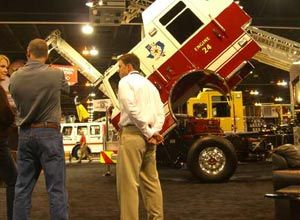By Jerry Brant
 Photo Jamie Thompson |
Related Resources: |
An infusion of stimulus money into a 35-year-old federal program may bring new funding opportunities to the fire service. Under the $787 billion economic stimulus package, an additional $1 billion has been added to this year’s Community Development Block Grant program — and your department could be eligible to apply.
This is a 27 percent increase over the previous year’s allocation, according to John Laswick, a Community Development Specialist with the Department of Housing and Urban Development, which administers the program.
Since 1974, the CDBG program has provided grants to eligible units of general municipal government for a wide range of activities that facilitate revitalization of local communities. In recent years competition for these funds has intensified as needs have increased and other sources of funding have diminished. But fire and EMS departments have successfully accessed the program to assist them in financing a number of qualified projects.
As with other stimulus funds, Laswick said, the federal government wants to put this money to use as quickly as possible. He said he expects the program announcement to be made late this month or early April. Grantees will then prepare an action plan amendment; HUD will expedite the processing of these plans, execute grant agreements and make the funds available to the grantees. HUD is looking for eligible projects that can be advertised for bid and be under contract within 120 days.
Public services
Up to 15 percent of CDBG money may be used by municipalities for public services, which includes fire, police and EMS as well as areas such as daycare programs and public health centers. If you are interested in accessing this funding, you should initiate dialogue with your state, county, or local planning or development agencies without delay.
Because this program is being treated as an amendment to the community’s existing action plan, the local municipality may not be required to hold public hearings on its intended use of these new funds. In other words, if you don’t approach your local government with your new request it may simply develop its CDBG action plan amendment from leftover projects that could not be funded in the past.
Here’s what you should be doing:
- Start by determining the amount of increased funding your municipality will receive this year.
- Next develop a list of possible initiatives you would like to present for consideration by your local government. While doing this, please keep in mind the 15 percent limitation on spending for public services and the 120 day time limitation for securing bids and signing a contract that HUD has imposed.
- Then create a short program narrative in letter form. This should include a brief description of the project, including a schedule of activities, a project budget, and a concise narrative describing the benefits the community will obtain from your project.
- Once completed, promptly deliver this letter to the appropriate person in your municipality in order to be considered for this opportunity. During this visit, take a minute to inform them about your request and inquire if your municipality is having a public hearing for the CDBG process. If they are, attend this meeting and get your request on the public record.
- By the end of this process, you should have some idea if your project will be considered for inclusion in the community’s action plan amendment to HUD.
If this seems like a lot to accomplish in a short period of time, just consider it another normal day in the fire service. You can’t afford to overlook this opportunity because I doubt that we will see anything like it in the near future.
Success story
One example of departments benefiting from the program in the past is the DuBois Fire Department in Pennsylvania. The department protects the city of DuBois, operating out of five stations with 462 volunteer firefighters.
“Over the years, the department has accessed the CDBG program to purchase new apparatus, to build new fire stations, and to buy new SCBA,” said Mayor Herm Suplizio. The mayor knows first hand the difficulties volunteer departments have in raising sufficient funds; he is also a member of the DuBois Fire Department and served as its chief for two years.
The fire department and the city have a policy of replacing one of the department’s six engines every five years. In order to accomplish this objective, a portion of each year’s CDBG funds are designated for apparatus replacement.
Last year, the department bought a new engine that cost almost $500,000, with the majority of this money coming from the CDBG program. The mayor says the city has already completed its 2009 CDBG “action plan,” and included in the proposal is funding for a new ramp at its Third Ward Fire Station. “CDBG has helped us to do a number of projects that we never would be able to do on our own,” Mayor Suplizio said.












